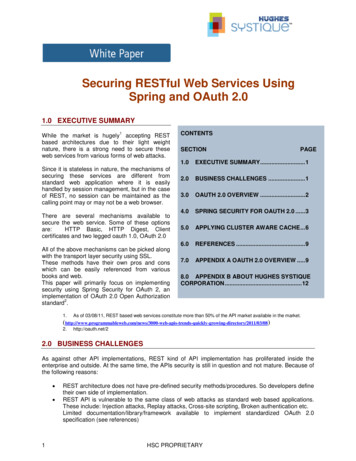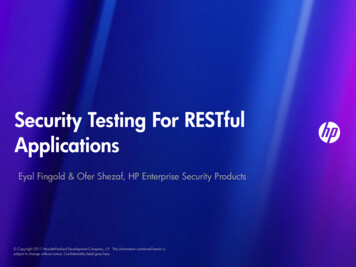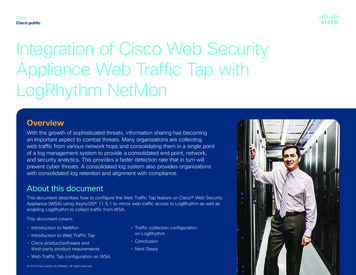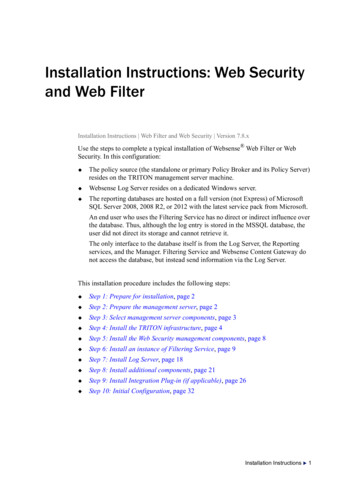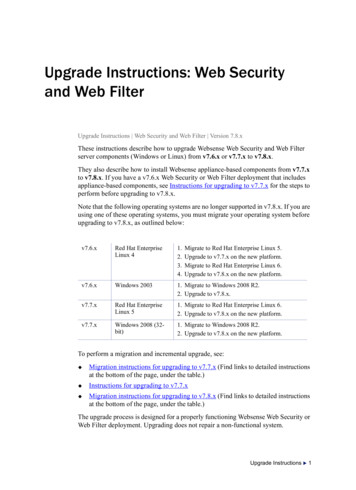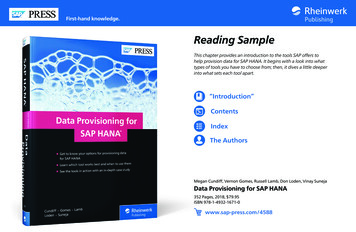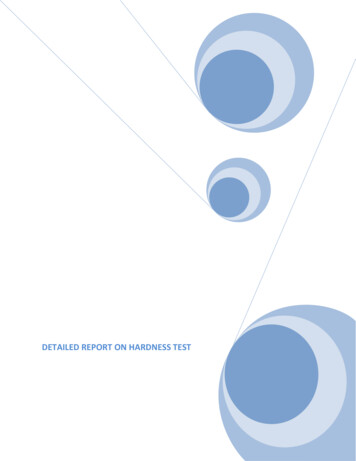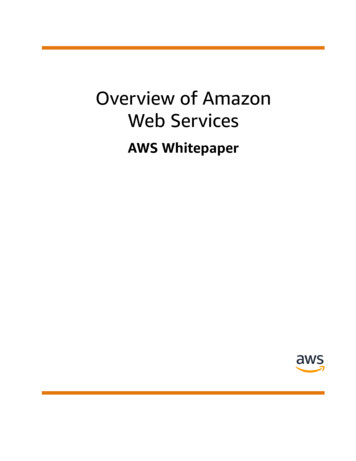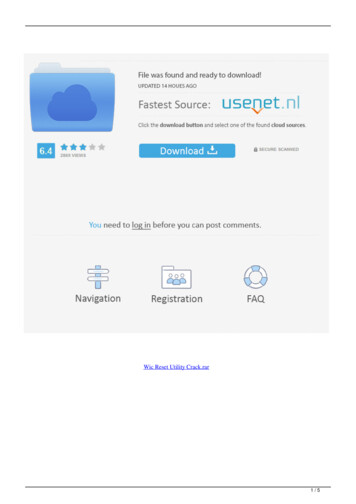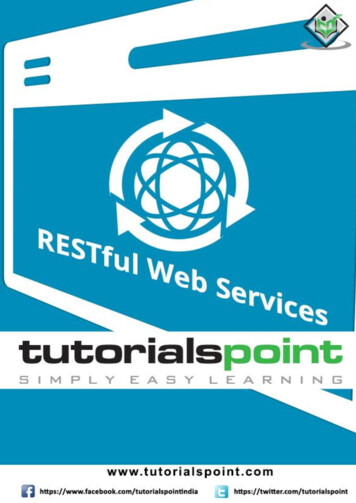
Transcription
RESTful Web Servicesi
RESTful Web ServicesAbout the TutorialRESTful Web Services are basically REST Architecture based Web Services. In RESTArchitecture everything is a resource. RESTful web services are light weight, highlyscalable and maintainable and are very commonly used to create APIs for web-basedapplications.This tutorial will teach you the basics of RESTful Web Services and contains chaptersdiscussing all the basic components of RESTful Web Services with suitable examples.AudienceThis tutorial is designed for Software Professionals who are willing to learn RESTful WebServices in simple and easy steps. This tutorial will give you great understanding onRESTful Web Services concepts and after completing this tutorial you will be atintermediate level of expertise from where you can take yourself at higher level ofexpertise.PrerequisitesBefore proceeding with this tutorial, you should have a basic understanding of JavaLanguage, Text Editor, etc. Because we are going to develop web services applicationsusing RESTful, so it will be good if you have understanding on other web technologies likeHTML, CSS, AJAX, etc.Copyright & Disclaimer Copyright 2016 by Tutorials Point (I) Pvt. Ltd.All the content and graphics published in this e-book are the property of Tutorials Point (I)Pvt. Ltd. The user of this e-book is prohibited to reuse, retain, copy, distribute or republishany contents or a part of contents of this e-book in any manner without written consentof the publisher.We strive to update the contents of our website and tutorials as timely and as precisely aspossible, however, the contents may contain inaccuracies or errors. Tutorials Point (I) Pvt.Ltd. provides no guarantee regarding the accuracy, timeliness or completeness of ourwebsite or its contents including this tutorial. If you discover any errors on our website orin this tutorial, please notify us at contact@tutorialspoint.comi
RESTful Web ServicesTable of ContentsAbout the Tutorial . iAudience. iPrerequisites. iCopyright & Disclaimer . iTable of Contents. ii1. RESTFUL WEB SERVICES – INTRODUCTION. 1What is REST? . 1RESTFul Web Services . 1Creating RESTFul Web Service . 12. RESTFUL WEB SERVICES – ENVIRONMENT SETUP . 3Setup Java Development Kit (JDK) . 3Setup Eclipse IDE . 3Setup Jersey Framework Libraries . 4Setup Apache Tomcat . 53. RESTFUL WEB SERVICES – FIRST APPLICATION . 7Creating a Java Project . 7Creating the Source Files. 9Creating the Web.xml configuration File . 134. RESTFUL WEB SERVICES – RESOURCES . 16What is a Resource?. 165. RESTFUL WEB SERVICES – MESSAGES . 186. RESTFUL WEB SERVICES – ADDRESSING . 217. RESTFUL WEB SERVICES – METHODS . 22ii
RESTful Web ServicesTesting the Web Service . 318. RESTFUL WEB SERVICES – STATELESSNESS . 359. RESTFUL WEB SERVICES – CACHING . 3610.RESTFUL WEB SERVICES – SECURITY . 3811.RESTFUL WEB SERVICES – JAVA (JAX-RS). 40Specifications. 40iii
1. RESTful Web Services – IntroductionRESTful Web ServicesWhat is REST?REST stands for REpresentational State Transfer. REST is a web standards basedarchitecture and uses HTTP Protocol for data communication. It revolves around resourceswhere every component is a resource and a resource is accessed by a common interfaceusing HTTP standard methods. REST was first introduced by Roy Fielding in year 2000.In REST architecture, a REST Server simply provides access to resources and the RESTclient accesses and presents the resources. Here each resource is identified by URIs/Global IDs. REST uses various representations to represent a resource like Text, JSON andXML. JSON is now the most popular format being used in Web Services.HTTP MethodsThe following HTTP methods are most commonly used in a REST based architecture. GET - Provides a read only access to a resource. PUT - Used to create a new resource. DELETE - Used to remove a resource. POST - Used to update an existing resource or create a new resource. OPTIONS - Used to get the supported operations on a resource.RESTFul Web ServicesA web service is a collection of open protocols and standards used for exchanging databetween applications or systems. Software applications written in various programminglanguages and running on various platforms can use web services to exchange data overcomputer networks like the Internet in a manner similar to inter-process communicationon a single computer. This interoperability (e.g., between Java and Python, or Windowsand Linux applications) is due to the use of open standards.Web services based on REST Architecture are known as RESTful Web Services. These webservices use HTTP methods to implement the concept of REST architecture. A RESTful webservice usually defines a URI (Uniform Resource Identifier), which is a service that providesresource representation such as JSON and a set of HTTP Methods.Creating RESTFul Web ServiceIn this tutorial, we will create a web service called User Management with the followingfunctionalities:1
RESTful Web ServicesSr.No.HTTPMethod1GET/UserService/usersGet list of usersRead Only2GET/UserService/users/1Get User with Id 1Read Only3PUT/UserService/users/2Insert User with Id 2Idempotent4POST/UserService/users/2Update User with Id 2N/A5DELETE/UserService/users/1Delete User with Id 1Idempotent/UserService/usersList the supportedoperations in webserviceRead Only6OPTIONSURIOperationOperation Type2
2. RESTful Web Services – Environment SetupRESTful Web ServicesThis tutorial will guide you on how to prepare a development environment to start yourwork with Jersey Framework to create RESTful Web Services. Jersey frameworkimplements JAX-RS 2.0 API, which is a standard specification to create RESTful WebServices. This tutorial will also teach you how to setup JDK, Tomcat and Eclipse on yourmachine before you the Jersey Framework is setup.Setup Java Development Kit (JDK)You can download the latest version of SDK from Oracle's Java site: Java SE Downloads.You will find the instructions for installing JDK in the downloaded files. Follow the giveninstructions to install and configure the setup. Finally set the PATH and JAVA HOMEenvironment variables to refer to the directory that contains Java and Javac, typicallyjava install dir/bin and java install dir respectively.If you are running Windows and installed the JDK in C:\jdk1.7.0 75, you would have toput the following line in your C:\autoexec.bat file.set PATH C:\jdk1.7.0 75\bin;%PATH%set JAVA HOME C:\jdk1.7.0 75Alternatively, on Windows NT/2000/XP, you could also right-click on My Computer selectProperties then Advanced then Environment Variables. Then, you would update thePATH value and press the OK button.On Unix (Solaris, Linux, etc.), if the SDK is installed in /usr/local/jdk1.7.0 75 and you usethe C Shell, you would put the following into your .cshrc file.setenv PATH /usr/local/jdk1.7.0 75/bin: PATHsetenv JAVA HOME /usr/local/jdk1.7.0 75Alternatively, if you use an Integrated Development Environment (IDE) like BorlandJBuilder, Eclipse, IntelliJ IDEA, or Sun ONE Studio, compile and run a simple program toconfirm that the IDE knows where you installed Java, otherwise do proper setup as givendocument of the IDE.Setup Eclipse IDEAll the examples in this tutorial have been written using the Eclipse IDE. So, I wouldsuggest you should have the latest version of Eclipse installed on your sebinariesfrom http://www.eclipse.org/downloads/. Once you downloaded the installation, unpackthe binary distribution to a convenient location. For example, in C:\eclipse on windows, or/usr/local/eclipse on Linux/Unix and finally set the PATH variable appropriately.Eclipse can be started by executing the following commands on a windows machine, oryou can simply double click on eclipse.exe3
RESTful Web Services%C:\eclipse\eclipse.exeEclipse can be started by executing the following commands on Unix (Solaris, Linux, etc.)machine: /usr/local/eclipse/eclipseAfter a successful startup, if everything is fine, then your screen should display thefollowing result:Setup Jersey Framework LibrariesNow, if everything is fine, then you can proceed to setup the Jersey framework. Followingare a few simple steps to download and install the framework on your machine. Make a choice whether you want to install Jersey on Windows, or Unix and thenproceed to the next step to download the .zip file for windows and then the .tz filefor Unix. Download the latest version of Jersey framework binaries from the following link –https://jersey.java.net/download.html. At the time of writing this tutorial, I downloaded jaxrs-ri-2.17.zip on my Windowsmachine and when you unzip the downloaded file it will give you the directorystructure inside E:\jaxrs-ri-2.17\jaxrs-ri as shown in the following screenshot.4
RESTful Web ServicesYou will find all the Jersey libraries in the directories C:\jaxrs-ri-2.17\jaxrs-ri\lib anddependencies in C:\jaxrs-ri-2.17\jaxrs-ri\ext. Make sure you set your CLASSPATHvariable on this directory properly otherwise you will face problem while running yourapplication. If you are using Eclipse, then it is not required to set the CLASSPATH becauseall the settings will be done through Eclipse.Setup Apache TomcatYou can download the latest version of Tomcat from http://tomcat.apache.org/. Once youdownloaded the installation, unpack the binary distribution into a convenient location. Forexample in C:\apache-tomcat-7.0.59 on windows, or /usr/local/apache-tomcat-7.0.59 onLinux/Unix and set CATALINA HOME environment variable pointing to the installationlocations.Tomcat can be started by executing the following commands on a windows machine, oryou can simply double click on startup.bat.%CATALINA \startup.batTomcat can be started by executing the following commands on a Unix (Solaris, Linux,etc.) machine: CATALINA 59/bin/startup.shAfter a successful startup, the default web applications included with Tomcat will beavailable by visiting http://localhost:8080/. If everything is fine then it should displaythe following result:5
RESTful Web ServicesFurther information about configuring and running Tomcat can be found in thedocumentation included on this page. This information can also be found on the Tomcatwebsite: http://tomcat.apache.org.Tomcat can be stopped by executing the following commands on a windows machine:%CATALINA utdownTomcat can be stopped by executing the following commands on Unix (Solaris, Linux, etc.)machine: CATALINA .59/bin/shutdown.shOnce you are done with this last step, you are ready to proceed for your first Jerseyexample which you w
RESTful Web Services 3 This tutorial will guide you on how to prepare a development environment to start your work with Jersey Framework to create RESTful Web Services. Jersey framework implements JAX-RS 2.0 API, which is a standard specification to create RESTful Web Services.
